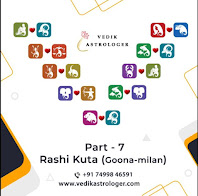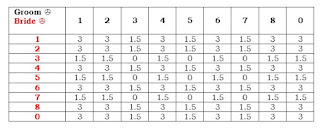Rashi Kuta also known as Bhakuta is the 7th parameter from Ashtakuta. It contributes a maximum of 7 points from the total 36 Goonas of Ashtakuta. The Rashi in which Moon is placed in the birth chart of Bride and Groom are considered here to check their compatibility for marriage.
Here in this Kuta, the distance between Bride’s and Groom’s Moon Rashi has to be counted. For example, if we consider the Bride of Mesh Rashi and Groom of Kark Rashi then the distance between the Bride’s Rashi to Groom’s Moon Rashi will be 4 and that of the Groom’s to the Bride’s will be 10. Similarly, there can be 07 combinations to match 1-1, 2-12, 3-11, 4-10, 5-9, 6-8, 7-7.
Out of these 2-12, 5-9, 6-8 combinations are not considered auspicious. The second house shows wealth accumulation, and the 12th house indicates expenditure/loss. This combination can create financial problems in the couple’s life. In the same way, the 5th house indicates parenthood (kids) and the 9th house does not take you to pleasure tours, also shows unconventional things and attracts more religiousness than love, hence 5-9 it shows trouble in having kids. 6th house is of sickness/enemy and 8th of death/end, it points towards incompatibility or divorce, health issues and death of a partner. In these conditions, the Goon Milan score will be zero (0).
Rest of the combinations are considered good for marriage matching and the Goona Milan score will be 07 for the couple out of 36 from Ashtakuta. It also indicates a healthy relationship between the couple. In the human body, the Moon represents the mind, and if the points are matching we can say the understanding between the couple will be good, adjustments made by them will bear fruit.
Rashi Kuta (Bhakuta) Dosh is considered nullified if the lord of Moon signs of Bride and Groom are the same or the lords are friendly towards each other.



.jpeg)

.jpeg)



.jpeg)

.jpeg)

.jpeg)



.jpeg)

